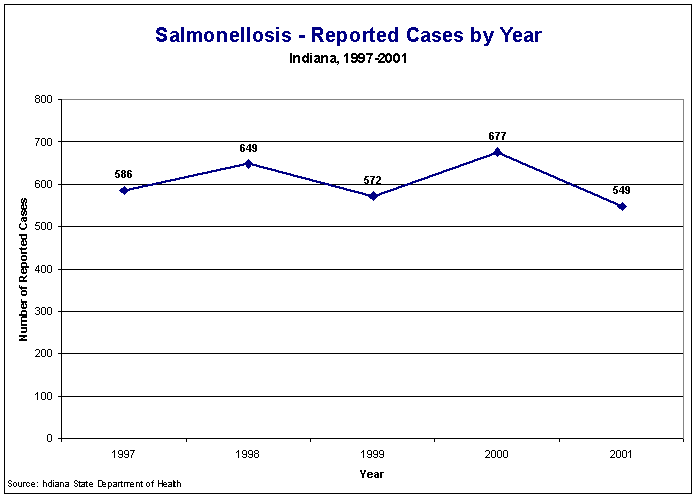Figure Sal1: Salmonellosis - Reported Cases by Year, Indiana, 1997-2001

2001 Indiana Report of Infectious Diseases |
View ISDH's Quick Facts on Salmonella
View CDC's Salmonella page
Rates presented are per 100,000 population and are based on the 2000 U.S. Census.
| Cases | Incidence Rate |
|
| Total | 549 | 9.0 |
| Race-specific cases and rates1 | ||
| White | 321 | 6.0 |
| Black | 33 | 6.5 |
| Other2 | 6 | 2.4* |
| Sex-specific cases and rates3 | ||
| Female | 286 | 9.2 |
| Male | 262 | 8.8 |
Salmonellosis is a bacterial disease usually transmitted through raw or undercooked foods of animal origin or foods cross-contaminated by animal products or feces. It can also be transmitted person-to-person. Common reservoirs include poultry, swine, cattle, rodents, reptiles, and wild birds, such as ducks and geese.
The incidence of salmonellosis in Indiana in 2001 decreased by 19% from 2000, with 549 cases reported (Figure Sal1), or 9.0 cases per 100,000 population. This incidence is below the previous five-year average of 607 cases. The incidence was greatest during the summer months (Figure Sal2).
Age-specific incidence rates were greatest among infants (48.5) followed by preschoolers (23.0) (Figure Sal3). The sex-specific and race-specific incidence rates show very little difference between sexes and races. There were no outbreaks of salmonellosis reported in Indiana in 2001.
Of those counties that reported 5 or more cases, Dubois County had the highest incidence rate (22.7), followed by Warrick (21.0), Jasper (20.0), and White (19.8) (Figure Sal4). The number of reported cases for Indiana counties can be found in Table Sal1.
There are over 3,000 different Salmonella serotypes that differ in somatic and flagellar antigens. The ISDH requests that clinical laboratories submit all positive Salmonella isolates to the ISDH Laboratories for free confirmation and serotyping. During 2001, serotypes were determined for approximately 96% of the 524 isolates submitted. Figure Sal5 shows the distribution of serotypes from initial and reference specimens submitted to the ISDH Enterics Laboratory. Of the 502 Salmonella isolates of known serotype, 115 (25%) were typhimurium (including 11 that were Copenhagen variant), 98 (20%) were enteritidis, 40 (8%) were newport, 38 (8%) were heidelberg, 29 (6%) were java, and the remaining 182 (36%) were other serotypes.
Back to Top of Article
Back to Table of Contents
|
Figure Sal1: Salmonellosis - Reported Cases by Year, Indiana, 1997-2001 |
|
|
Back to Reference in Text
Back to Top of Article
|
Figure Sal2: Salmonellosis - Reported Cases by Month, Indiana, 2001 |
|
|
Back to Reference in Text
Back to Top of Article
|
Figure Sal3: Salmonellosis - Incidence Rates by Age Group, Indiana, 2001 |
|
|
Back to Reference in Text
Back to Top of Article
|
Figure Sal4: Salmonellosis - Incidence Rates by County, Indiana, 2000 |
|
|
Back to Reference in Text
Back to Top of Article
|
Table Sal1: Salmonellosis - Reported Cases by County, Indiana, 2001 |
||||||||||||||||||||||||||||||||||||||||||||||||||||||||||||||||||||||||||||||||||||||||||||||||||||||
|
||||||||||||||||||||||||||||||||||||||||||||||||||||||||||||||||||||||||||||||||||||||||||||||||||||||
Back to Reference in Text
Back to Top of Article
|
|
Back to Reference in Text
Back to Top of Article
1 - Race was unknown for 189 of the reported cases.
2 - "Other" includes American Indian/Alaska Native, Asian, Native Hawaiian/Pacific Islander, and multiracial.
3 - Sex was unknown for 1 of the reported cases.
* - Rate based on less than 20 cases and should be considered unstable.
Back to Table of Contents
[an error occurred while processing this directive]